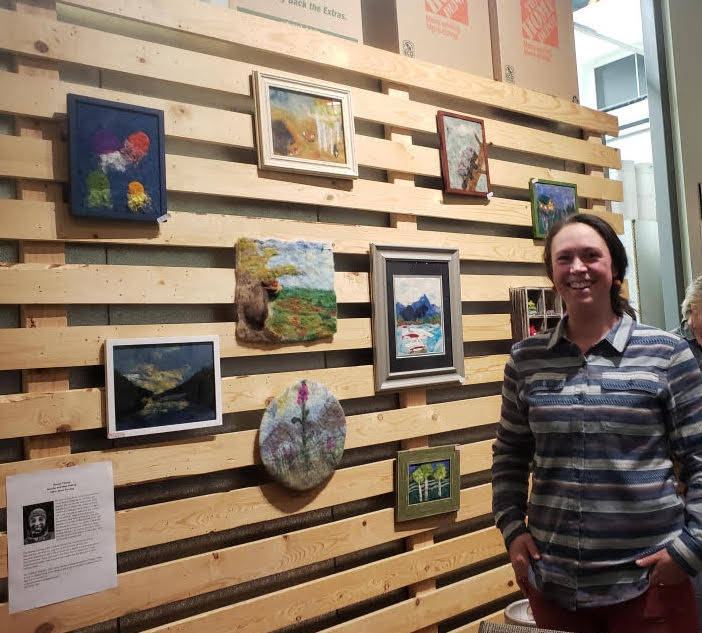Using the fiber technique of needle felting, artist Hanna Young creates bold, colorful sculptures and two-dimensional landscapes. While pleasing as visual art for all to experience, Young also uses this technique as a way to inspire storytelling with her preschool students.
Young’s work is on display at Grace Ridge Brewery for the rest of this month.
Originally from Anchorage, Young has been living in Homer since 2011 with her husband Brandon and two young sons, Theodore and Larkin.
She is the founder of Tiny Trees, the umbrella organization that includes several programs for preschoolers and young people in the community. Through a certification in early childhood education, she began exploring the art of needle felting.
However, that’s not where the inspiration launched.
“I learned to knit at the Waldorf elementary school in Anchorage. We made our own needles and then used the knitting process as a tool for mathematics study,” she said. “I do still knit but I find needle felting more satisfying these days.”
In her artist description Young explains, “needle felting is when you take wool fibers and use a needle to shape them into a 3D form or a flat surface. One uses a foam board under the wool fibers and a very sharp needle with barbs. The needle grabs onto the wool fibers and gets the wool to condense and stick together in a matted form. Wool has scales and when you push a barbed needle through the wool it makes the fibers stick together. You can create almost anything you want.”
The January show at Grace Ridge Brewery in Homer is Young’s first personal exhibit and includes small scenes of locally inspired images such as a float plane, a boat and whale tail, an Alaska cabin on Diamond Ridge, flowering fireweed, and a marine cove in Kachemak Bay, as well as three-dimensional puppetry pieces that she uses regularly with children in her daily childcare work.
Her creature creations have a general tone of gnomes, fairies, animals and magical outdoor themes.
They are bright and colorful but also with simple, natural features that encourage independent creativity. This theme is similar to what Young offers overall to youth who participate in her forest school, a melody of imagination and nature.
She also creates colorful, detailed play-mat landscapes that serve as “a storytelling apron” or backdrop for sharing stories or songs with her preschoolers.
“Usually I pick a story to tell the children that will relate to something they’ll experience during the day,” Young said.
Both the landscape of the story and the characters presented are a personal creation of Young, but with a design inspired specifically in Waldorf style to allow each child’s own sense of discovery and interpretation for what the events of the day may hold.
As Young wrote in her artist statement, “all of the pictures and puppets are from adventures I have had around the state.” In the display at Grace Ridge, she showed one particular, place-mat size “landscape” incorporating the scene of a bright blue river flowing through the center and various woodland features along the banks, such as rocks, mushrooms and grassy grazing ground for a moose puppet.
One particularly interesting feature of this play-mat is the way she has designed them with snaps on the corners to create a boundary for the puppets to stay more contained when a child plays with the mat when mobile, such as on an airplane or boat ride.
This is the first show of her artwork in Homer and what is displayed can be purchased there. She does not currently sell it at any local outlet, but has been in touch with retailers; it’s just a matter of having enough pieces available to set up a display.
In addition to this show, she has taught one gnome felting class through the Homer Folk School (she says she’d consider doing it again) and offers potential buyers an opportunity to make special orders of felt creatures based on photos of their own special pets and animals through a Facebook link, “Hanna’s Wooly Shop.”
Emilie Springer is a freelance writer, a lifelong Alaskan and a descendant of the original Ninilchik settlers.
• By Emilie Springer, For the Homer News

